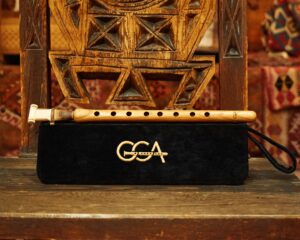
Duduk Special Gift Set in a Hard Case
Enhance Your Duduk Experience: A Special Gift Set in a Hard Case

The duduk, a double-reed instrument with an ancient history, is an integral part of Armenian musical culture. Its origins can be traced back over 4,000 years, making it one of the world’s oldest musical instruments still in use today. The duduk’s unique and soulful sound, derived from its natural materials, evokes a sense of warmth and emotion that resonates deeply with both players and listeners alike.
Duduk Teacher:
Learning a new instrument can be a daunting task, but having the guidance of a skilled duduk teacher can make all the difference. A duduk teacher is like a musical mentor who imparts knowledge, techniques, and a deep understanding of this ancient instrument. They’ll teach you the proper posture, finger placements, breath control, and how to produce those distinct duduk tones. With their expertise, you’ll progress steadily, developing both technique and musicality.
Duduk Lessons Online:
In this digital age, you don’t need to travel to a distant music school to learn the duduk. Online duduk lessons have become a popular and accessible way to learn this instrument from the comfort of your home. Websites like DudukMaster offer comprehensive video lessons, guiding you step by step through the intricacies of duduk playing. From the fundamentals to advanced techniques, you’ll have a virtual instructor at your fingertips, ready to help you navigate this musical journey.
How Hard Is It to Learn the Duduk?
The duduk’s allure lies in its simplicity and complexity intertwined. It’s a paradoxical instrument where its primitive nature can be both a challenge and a reward. The process of coaxing beautiful sounds from a duduk can be initially tough due to its unique double reed and delicate reed adjustments. However, the emotional resonance and rich timbre it offers make the journey truly worthwhile.
The duduk’s structure, crafted from apricot wood, is deceptively simple. Eight finger holes on the front and two on the back create a canvas for melodies that have stood the test of time. Mastering breath control, finger placement, and the elusive technique of vibrato are integral to achieving the duduk’s signature soulful sound.
Here are some goals for learning duduk.
Note Reading and Interpretation: Develop proficiency in deciphering musical notation for translating written melodies into expressive duduk performances.
Harmonizing with Rhythmic Precision: Cultivate precise rhythm awareness, ensuring seamless alignment of melodies with beats and cadences for meticulous performances.
Mastering Technique Variations: Explore techniques like vibration, staccato, trill, and dynamics, incorporating layers of expression and nuance into your musical renditions.
Rudiments of Musical Theory: Establish a sturdy foundation in musical theory, enhancing overall comprehension and providing tools for navigating intricate melodic structures.
Ear Training Essentials: Hone the ability to accurately discern and reproduce melodies through focused ear training, a pivotal skill enhancing authenticity and mastery in duduk performances.
Whether you’re an aspiring musician or simply captivated by the duduk’s charm, take the plunge. Embrace the challenges, relish the small victories, and let the duduk’s hauntingly beautiful tunes lead you on an unforgettable musical adventure. And when you’re ready to begin, explore the wealth of online resources available, including DudukMaster’s video lessons, guiding you step by step towards mastering the ancient melodies of the duduk.

Enhance Your Duduk Experience: A Special Gift Set in a Hard Case

Duduk Instrument Prices There are a number of factors that can affect
GGA represents professional musical instruments, that are recognized all over the world. The instruments are exclusively hand-made works. Feel the spirit of the orient music.